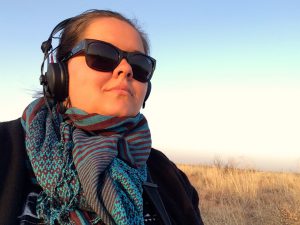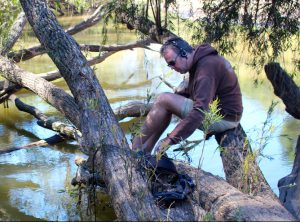The scientific art of freshwaterecoacousticshas beenrecognisedwith two illustrious grants that will help propel the unique, interdisciplinary field.
Griffith UniversityresearchersDrLeah Barclay,from the Queensland Conservatorium Research Centre (QCRC), andDrSimon Linke,from Australian Rivers Insititute (ARI),received an Australian Council Grant(ACG)to produce sound maps across Australia.
Dr Linkewas also named a National Geographic Explorer,which will allow him tocharacterisetheacoustic fingerprintsof12 fish species in North Queensland.

Dr Leah Barclay.
The Australia Council grant will fund the researchers’ interdisciplinary project‘River Listening from Source to Sea: Towards a Live Sound Map of Australian Freshwater Ecosystems’, which will result in a portfolio of outcomes including an interactive website and mobile application designed to understand the biological and cultural diversity of river systems in Australia through sound.
This builds on the success ofRiver Listening, a long-term collaboration between the QCRC and ARI that has resulted in high-impact publications, grants and major creative works that have toured internationally.
This project will work directly with remote and regional communities along the Fitzroy River (WA), the Mary River (QLD) and the Murray River (VIC / SA). The team will record and map each location and engage with diverse knowledge systems through interdisciplinary workshops exploring the soundscapes of the river from source to sea through hydrophone recordings and local soundscapes.
In a world-first, the catchment-to-coast design of this project will investigate gradual changes in river soundscapes through mapping expeditions led by indigenous custodians and facilitated by artists and scientists who have pioneered the use of sound as a non-invasive tool for monitoring river health.
“Griffith University has rapidly become a leader in the field of freshwaterecoacousticswith researchers at the Australian Rivers Institute and Queensland Conservatorium Research Centre developing new ways to understand river health through sound,” Dr Barclay said.
Dr Linke’s National Geographic Explorer grant will enable his project‘Characterisingfish song in northern Australian rivers to support ecosystem monitoring’to furtheracoustic monitoring in river systemsin North Queensland.

Dr Simon Linke.
Despite the fact thatfishvocalisationshave been common knowledge since thetime of Aristotle, nocomprehensiveefforts to catalogue freshwater fish sounds have been undertaken. In major sound archives,fewfreshwater fish are amongthe >200 000 publicly accessible recordings.
Dr Linke and his team from JCU, Monash and France, as well theEwamianAboriginal Corporation,plan to catalogue calls from all the knownsoniferousspecies in the study area – 7 grunters and 5 catfish taxa.
A complete archive for a regionwould bea world first – it would lay thefoundation for multiple follow-up projects, including evolutionary exploration of fishvocalisationsand large scale underwater acoustic monitoring of fish populations.
“While we have worked on technical and analysis issues, we often do not know exactly which species makes the sound,” Dr Linke said.
“Fish – like birds – have an acoustic fingerprint that is species specific. We just received National Geographic funding tocharacterisethis acoustic fingerprint for 12 fish species in North Queensland.”
